.png?width=1000&name=Event%20Headers%20Template%20(37).png)
As anyone who has launched a campus engagement program knows, it can be difficult to tell how students view the changes to their campus experience. Are they enjoying your new app? Are they finding student engagement opportunities easily?
Have you considered asking them?
With the Qualtrics API integration from Suitable, administrators, professors and advisors can run student experience surveys and send them directly to students using our student engagement app and the real-time mobile nudges capability.
What is a student experience survey?
A student experience survey is exactly what it sounds like: an ongoing effort to collect student feedback on the many aspects of life on campus.
But while the concept may sound simple enough – with most major universities running several student experience surveys per year – the data that schools collect can vary greatly.
If your goal is to increase student engagement, ensure development and retention, and ultimately gauge progress towards career readiness competencies, you may ask different types of questions than if you are trying to gauge enjoyment in things like on-campus concerts and the food in the dining halls.
So how do Suitable partners effectively utilize the Qualtrics integration to get the student experience data they need to meet their strategic goals?
How to create a student experience survey that meets your goals
Determine Your Scope
The most important place to start for any survey project is to figure out exactly who you want to reach and why. To start, ask yourself one simple question: what are you hoping to do with this data once you have it?
This will help you determine your scope–undergraduate, graduate or both? Law students, business students or everyone?
If, for example, you want to find out how students view your student engagement program, you could choose to survey only students who have engaged with the program or are actively enrolled. But you may also want the perceptions of people not yet enrolled. It all depends on your goals.
When selecting a scope, try to keep it as narrow as possible. Instead of getting perceptions of an entire program with one survey, increase engagement by creating multiple short but illuminating surveys covering smaller areas. For example, instead of creating a survey to understand your entire Suitable-led program, create a survey about your communications strategy only. This will allow you to create shorter surveys that take very little time to complete. Once students see they can engage without it taking too much of their time, they are more likely to fill out the next survey you send.
Once you have your scope identified, try to avoid expanding beyond it. Asking too many unrelated questions can cause students to drop off before completion or provide fewer details per response.
Question Pathing
Some questions provide simple yes or no answers and give insight all on their own. But others are more complicated.
Let’s say that you want to know if a survey recipient has enrolled in your higher education engagement program. Depending on their answer, you may want to ask different follow-up questions.
With Qualtrics Survey Flow, you can add survey pathing, allowing you to choose a different set of questions based on a prior answer, creating multiple paths to completion of the survey.
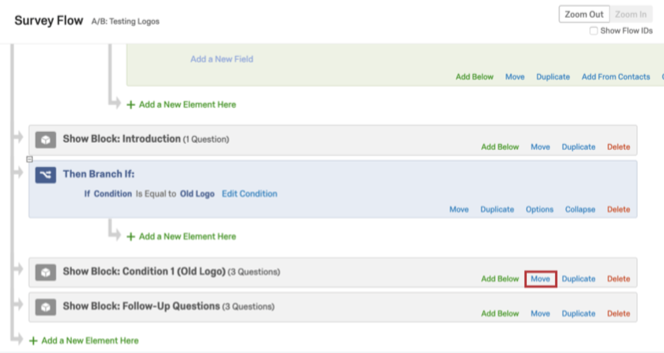
Make sure you use quantitative (multiple choice) questions for these, as responses can become difficult to unpack otherwise.
Qualtrics allows the creation of different workflows based on recipient questions. A certain answer can change which questions or question types are displayed, or can even end the survey for the respondent.
With advanced reporting tools, Qualtrics allows you to get your survey results organized in a way that makes sense so you won't spend hours unpacking and reformatting the data.
Higher Education Survey Question Examples
While the content of any student experience survey will vary based on program goals, student population and more, certain survey types are more desirable for surveys meant to be taken on mobile phones.
Quantitative vs. Qualitative
Before we launch into the question examples, I wanted to provide a quick note about quantitative surveys versus qualitative questionnaires.
First of all, what is the difference between these two survey methodologies?
Quantitative Surveys
In a quantitative survey, respondents are asked to choose from a list of pre-provided responses. This has two important outcomes in the average survey.
First, reporting becomes a whole lot easier for the survey administrator--simply provide the question, the choices available and how many responses each choice received.
Secondly, these questions become much easier to answer–they don’t require much independent thought aside from a few pre-selected choices. This means that students are more likely to fill out the survey as it can be done quickly, especially from a mobile phone, and survey administrators are less likely to get deeply thought out insights, feelings and impressions as all answers are pre-selected.
To avoid shallow responses from students, try to think through ways to cover more potential responses; leave the option for responses beyond your pre-selected list (Ex: an 'Other' selection, with the option to provide more detail).
Also, be specific and intentional about the selections you offer to respondents and when you use multiple-choice vs. a more open-ended approach. If you want feedback on a specific feature and there are a finite amount of options within that feature, you have a slam-dunk quantitative question.
For example, if you only have three types of reflection, asking “What is your favorite reflection type to complete on the app?” makes for a great quantitative survey question. If instead, you ask “What is your favorite feature of our mobile app?” you may want to make this question open-ended. Despite the likelihood of a finite response, this question will create too long of a list to be quickly answered by a respondent.
Quantitative Higher Education Survey Question Examples
Net Promoter Score
Coming from the business world, Net Promoter Score (or NPS) has provided a way for businesses to showcase customer satisfaction by asking one simple question: on a scale of 1-10, how likely are you to recommend this product or service to a friend or colleague? This method has been used on apps and websites as well as for new retail products, movies and even internal technologies or practices.
As a college administrator, your students are your customers, and gaining their satisfaction is important. This simple question type can provide a straightforward look at how you are doing so far.
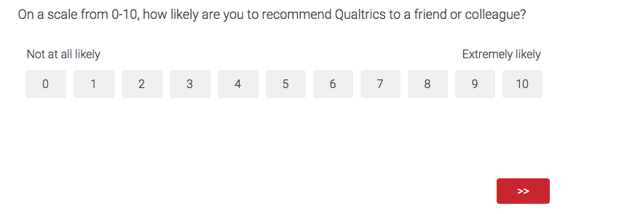
Slider
Possibly the easiest question to answer on a mobile device is the slider, allowing respondents to simply slide to their desired entry using the phone’s touchscreen.
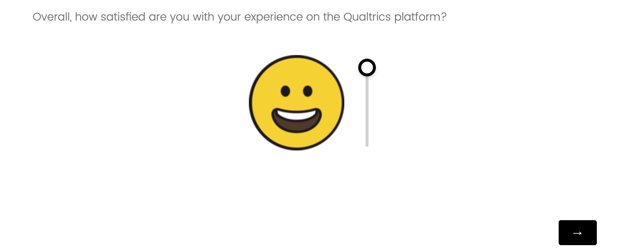
Matrix
Sometimes you want to gain a wider scope of information without sacrificing the reporting ease or potential falloff of a qualitative survey. That’s when a matrix question can come in handy. Gain insights on multiple features, functions and practices from one single, easy-to-use table of radio buttons.
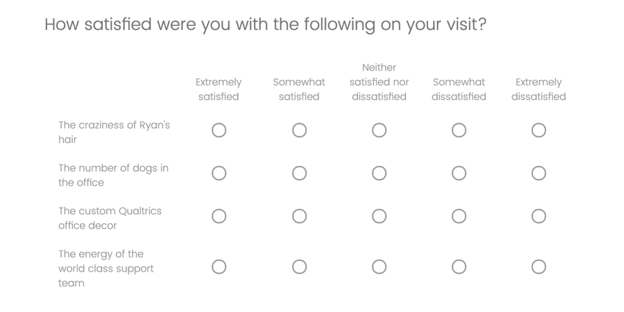
Check out the full list of Qualtrics-supported question types.
Qualitative Surveys
With qualitative research, administrators ask students to go deeper. Broad, open-ended questions can invoke longer, more nuanced responses that can reveal insights quantitative surveys cannot. The downside is that students may find filling out long responses on a phone annoying and may provide less detail. Imagine asking for impressions on your student engagement strategies and all you get back is “it was fine.”
To avoid this, be careful how you word your questions. Don’t use leading language as not to bias the responses you receive and, instead, focus on specific but open-ended questions designed to elicit the most detailed responses.
For example, instead of asking “Is Our App Fast & Responsive?” instead, you can ask “What Are Three Words You’d Use To Describe Our App?”
Another way to make your qualitative surveys more effective is to use open-ended questions to gather more detailed information on previous quantitative questions. For example, if you asked “Please Choose Your Favorite Reflection Type” as a multiple choice, you can then ask “Describe Your Reason For Choosing Your Favorite Reflection Type.” This way, you improve the amount of insights you collect. With the quantitative response, you can find out which reflection type students enjoy most. With the qualitative data, you can find out why they like the winner best and, perhaps more importantly, why they may not like the others as much.
Qualitative Higher Education Survey Question Examples
Text Entry
A simple question with a text field for responses. All Qualitative questions really expand from here, so Qualtrics gives you the ability to add media, sound and more for response. For example, if you want feedback on your new program’s branding materials or intro video, this would be a great place to get that.
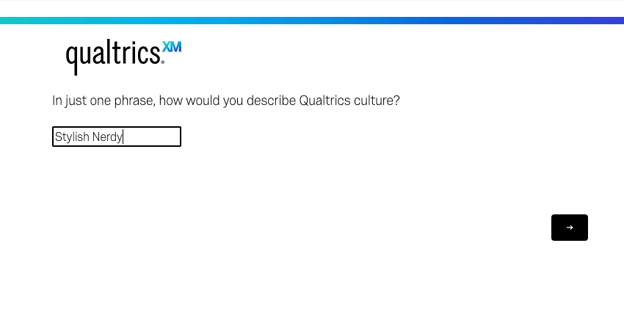
Want to create your first Suitable student experience survey? Request a demo today and we’ll show you how you can get started!


-1.png)